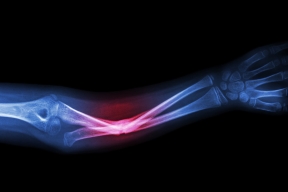Malunion and Nonunion Fractures: Orthopedic Cold Trauma
From an interview with
Dr. Jeremy Sparkman
McLeod Orthopaedics
Over the course of a lifetime, it is not unusal to experience an orthopedic injury to a bone or joint, such as a dislocation or fracture.
Orthopedic trauma often occurs suddenly, as the result of a fall or car accident. It can also happen over time, by overuse, such as a stress fracture.
In most cases, after orthopedic intervention, a fracture will heal with excellent alignment and hopefully with a return of normal or near-normal function. However, there are complications that can occur in the healing process that can result in the bone not healing properly or not healing at all, leading to a nonunion or a malunion.
What is a Nonunion?
A nonunion is when a fracture does not completely heal after an extended period of time, typically greater than six to nine months. A malunion is when a bone does not heal with acceptable alignment and can result in loss of function or cosmetic deformity. Both nonunions and malunions can leave individuals with instability, weakness, pain or loss of function.
We refer to these types of improperly healed bones as orthopedic “cold” trauma because they stem from injuries in the past. In contrast, an emergent traumatic injury, or one that has just occurred, would be a “hot” trauma.
Symptoms of a nonunion may be persistent pain, mobility issues at the fracture site, and a persistent fracture line on the X-ray. Nonunions are diagnosed using X-rays, CT scans, or other advanced imaging.
In addition to mechanical issues at the fracture site, there are many factors that can lead to a nonunion, including:
- Poorly controlled diabetes
- Hypothyroidism
- Vitamin D deficiency
- Tobacco use
Nonsurgical treatment for a nonunion can include electromagnetic or ultrasonic bone stimulation, bracing and lifestyle modifications.
Meanwhile, surgical treatment ranges from bone grafts to internal fixation, where plates, screws, rods, or a combination of implants are used to stabalize the nonunion.
What is a Malunion?
Malunions are the result of a fractured bone healing in an abnormal position. In some cases, a malunion may not require further treatment because it does not impair the patient’s movement. However, when the bones are significantly misaligned, surgery may be required to correct the problem. This involves an osteotomy, where the surgeon either shortens, lengthens, or realigns the bones so they can heal properly.
An orthopedic evaluation and consultation with an orthopedic surgeon is required to determine if a patient has a nonunion or malunion. To learn more, find an orthopedic specialist in your area.
-
McLEOD REGIONAL MEDICAL CENTER FLORENCE
843-777-2000 -
McLEOD DARLINGTON
843-777-1100 -
McLEOD DILLON
843-774-4111 -
McLEOD LORIS
843-716-7000 -
McLEOD SEACOAST
843-390-8100 -
McLEOD CHERAW
843-537-7881 -
McLEOD CLARENDON
803-433-3000



-
McLEOD REGIONAL MEDICAL CENTER FLORENCE
843-777-2000 -
McLEOD DARLINGTON
843-777-1100 -
McLEOD DILLON
843-774-4111 -
McLEOD LORIS
843-716-7000 -
McLEOD SEACOAST
843-390-8100 -
McLEOD CHERAW
843-537-7881 -
McLEOD CLARENDON
803-433-3000
 Find a Doctor
Find a Doctor  Locations
Locations  Services
Services 